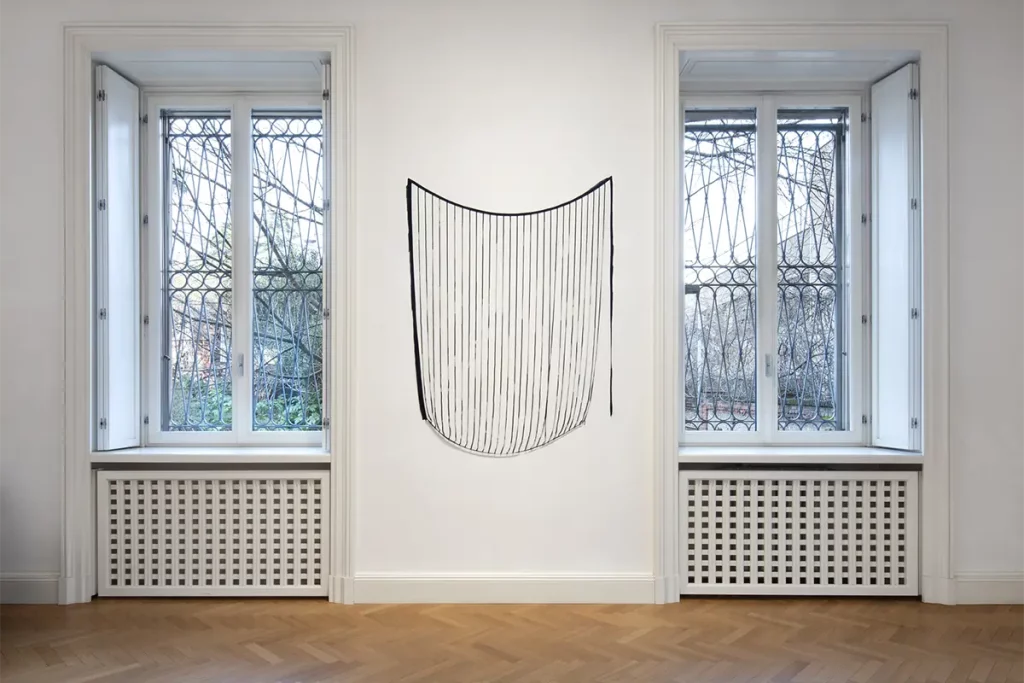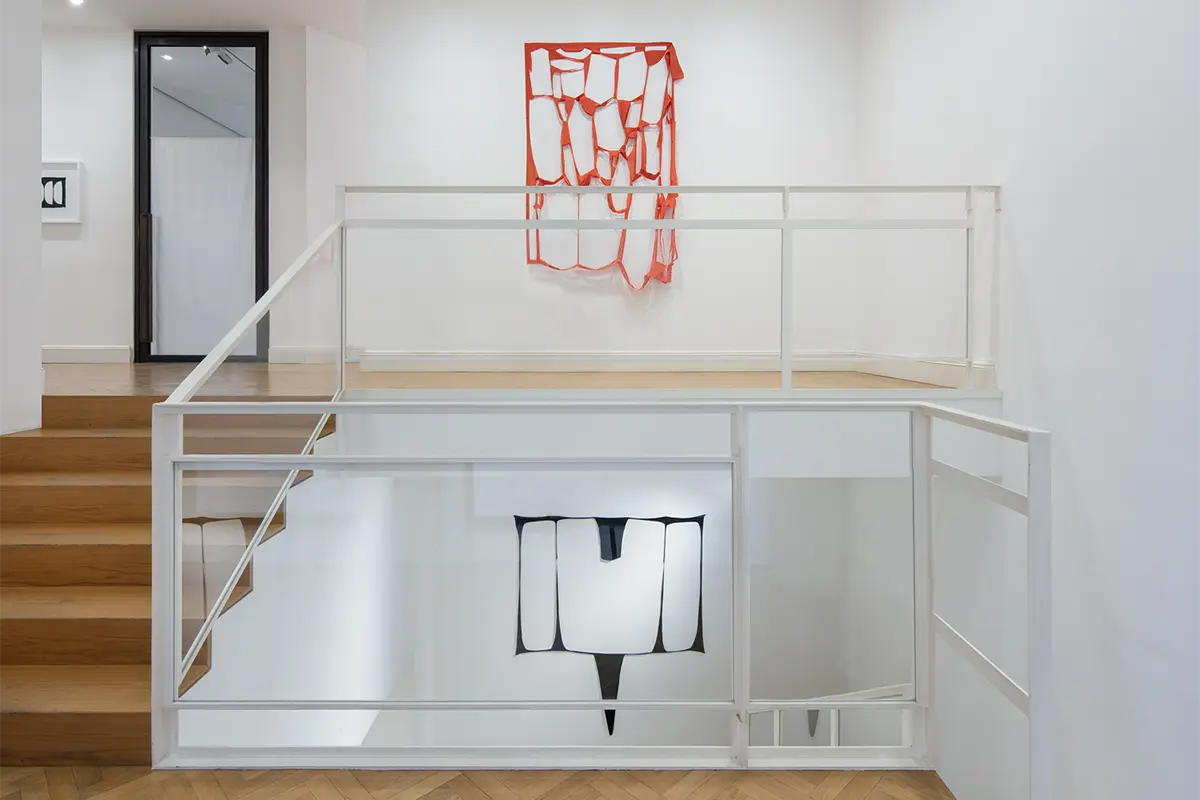The curiosity towards humanity, the desire to experiment with the unknown, fabric and movement: the Romanian textile artist talks about her latest solo show
The eclecticism and the experimentation with textiles in the art of Marion Baruch
From the beginning, her artistic journey has been focused on experimentation and eclecticism; nevertheless, fabric has always played a role in her life, both on a professional and personal level. «My connection to this material has been intertwined with my life since childhood. My grandfather had started working as an apprentice in a textile store in Timisoara, until he became the owner. In the early 1960s, I was traveling from Paris to Italy to sell my designs to textile companies. That’s how I met my husband. Being able to see up close the industrial work in the company he owned also influenced my artistic production», says Baruch.
Then again, the scraps from the fabric stores on the rue du Sentier during her stay in Paris, all the way up to 2012, when – after moving back to Gallarate – she started using the textile leftovers from the prêt-à-porter confections. Baruch’s works emerge as mysterious presences from the gallery’s white walls. Using different fabrics – sponge, nylon, polyester, viscose, etc. -, different in color and finishes – gaudy or dark; translucent or matte -, the artist plays with three-dimensionality, shadows and the empty-full dichotomy, as in Schwerkraft (2018) or Tre Pause (Three Pauses, 2015-19).
Textile scraps become metaphors of human fragility and humanity resilience
«Everything is personal; for me art and life coincide. The dichotomy between emptiness and fullness is central to my works, which I make with the scraps produced by the feverish rush for novelty that characterizes ready-to-wear, rescuing their beauty from waste. The process of interpreting these cutouts which I hang with small pins on the wall originates from a personal sense of urgency and culminates with a title, with giving them a name. It is an artistic process that draws from my own history and cultural references», states the artist.
Everything in this exhibition seems precarious – from the way the works are pinned to the walls to the gravity inexorably dragging them down –, except the artist’s will and vision, more vivid than ever after almost a century. The series of works Meccanismo di Precisione per Sculture (Precision Mechanism for Sculptures, 2023), which seem to float in an ethereal space, are paired with Un termometro in ogni casa (A thermometer in every house, 2023) – an artwork inspired by the collective experience of Covid-19 -, simultaneously conveying a sense of fragility and resilience typical of the human condition.
What’s behind the fashion production chain, between ethics and aesthetics
«The waste I use is nothing but the invisible side, what remains of the relentless process of overproduction in the fashion industry. In these leftovers is contained all the industrial and social work from which they derive, and in some way, they reveal the contradictions of this flow involving the social and cultural production of our society», explains the artist.
Through the works exhibited in Viasaterna, Baruch wants to shed light on the ethical issues embedded in the overproduction of the fashion sector, while valorizing its aesthetic side and the incessant flow of work and human effort. This research is linked to the investigations begun in the 1970s in the field of industrial production, considered by Baruch to be an essential dimension of contemporary creation. After the fortunate encounter with the gallery owner Luciano Inga Pin, who introduced her to the mechanisms of the art market, she founded the Name Diffusion brand in 1991, with the aim of making the production chain of the work of art visible.

Abito-Contenitore (1970) by Marion Baruch
In 1970, Baruch addressed the relationship between fashion and tradition, and between the image of women and their status in society with the performance Abito-Contenitore (Dress-Container, 1970). Covered from head to toe in a tombstone-shaped dark tunic, she paraded in Via Montenapoleone, the fashion street in Milan.
Her ground-breaking performance earned her the cover of the Italian weekly magazine Panorama: «Maybe what would change today would be the effect on the public – says Baruch. Back then, when I walked down Via Montenapoleone wearing this Abito-Contenitore, it caused a scandal. People were stunned, I was immediately photographed. A lot has also changed today regarding the role of women compared to then, but there is still a long way to go. Even today it would remain a work».
The human body-environment relationship: Contenitore-Ambiente (1970). Ethics and Aesthetics of Baruch
Space and the relationships it can establish with humanity and the human body are another recurring element in Baruch’s oeuvre, ethics and aesthetics. Among these is the performance Contenitore-Ambiente (Container-Environment, 1970), where the spectators became the activator of the performance. An innovative approach and vision for the time, which would be employed by many other artists in the following decades, especially in the sphere of performance art and happenings.
In Contenitore-Ambiente, people were enclosed in transparent spheres and, as in a large womb or in an air bubble, they rolled in via Manzoni, blocking the traffic. «It came from a desire to roll. Although I never went into these transparent spheres, some kids did. I exhibited Contenitore-Ambiente in the Domus showroom in Milan and I had also thought of a performance. Through AG Fronzoni I met the photographer Gianni Berengo Gardin who took some shots of the Contenitore-Ambiente as they rolled in the Arena Civica in Milan, which we rented for a whole day», she recalls.
The nomadic life of Marion Baruch – humanity as a whole
Movement is precisely the trait d’union of Baruch’s artistic and personal experience. Born in Timișoara in 1929, she enrolled at the Academy of Fine Arts in Bucharest and in 1949 found refuge in Israel, where she continued her studies at the Bezalel Academy of Arts and Design in Jerusalem. After living for a long time between France and Italy, in 2012 she moved permanently to Gallarate, a northern Italian city famous for its textile heritage.
From each of these places she was able to grasp something that would help her develop her original creative alphabet. When creating, Baruch lets herself be guided by the potential of movement or the musical rhythm of the material. A visceral approach that clearly emerges from the works exhibited in Viasaterna, each guardian of a piece of the artist’s life, but also of humanity as a whole.
A curiosity towards humanity. For Marion Baruch art and life are the same thing – the socio political issues, ethics and aesthetics
Starting from the 1990s, Baruch began to be interested in socio-political issues, such as genetics, immigration, and the phenomenon of sans papiers. Her most recent works pursue dialectical research between society and art, and between ethics and aesthetics. In over 90 years of living between different countries and cultures, she witnessed firsthand most of the socio-political crises and changes of the last century – wars, migrations, dictatorships, but also the advent of new scientific and technological frontiers.
A life devoted to art; an art inspired by life: «Woman, artist, for me there is no difference. Art and life are the same thing. And everything that happens to us has an imprint on our lives. My experiences have contributed to my nomadic nature, always seeking new things, and experimenting with the unknown. And they have cultivated my curiosity about others and humanity, with whom I have always sought relationships, my need to be with people».
Marion Baruch’s solo exhibition at Viasaterna, Milan
On January 30, the latest exhibition entirely dedicated to the artist of Romanian origins Marion Baruch opened to the public at Viasaterna, Milan. The solo show is a continuation of the collaboration begun in 2018, when the gallery put the work of the artist and activist born in Timisoara into dialogue with that of the emerging artist Alessandro Teoldi.
Marion Baruch’s ethics and aesthetics
On this occasion, the gallery premises hosts textile works created from 2012 to today with production waste from ready-to-wear fashion, combining ethics and aesthetics in an unexpected way. Baruch brings back to life old shreds of fabric on which she does not intervene except through the compositional gesture and the force of gravity. Color, shape, matter, and emptiness become the alphabet of an abstract but extremely eloquent visual language. The titling of the works is the final step of the creative process, for which Baruch draws from all the languages she learned during her nomadic life across Europe and the Middle East.
Marion Baruch
Marion Baruch was born in Timisoara in 1929 to parents of Hungarian origin and grew up in a highly unstable political and social context. Her artistic inclination first led her to Bucharest, then to Jerusalem, where she studied at the Bezalel Academy of Arts and Design, and finally to the Academy of Fine Arts in Rome. From 1993 until 2010 she lived in Paris, devoting herself to projects connected to relational art. And then back to Italy.
Agnese Torres



















